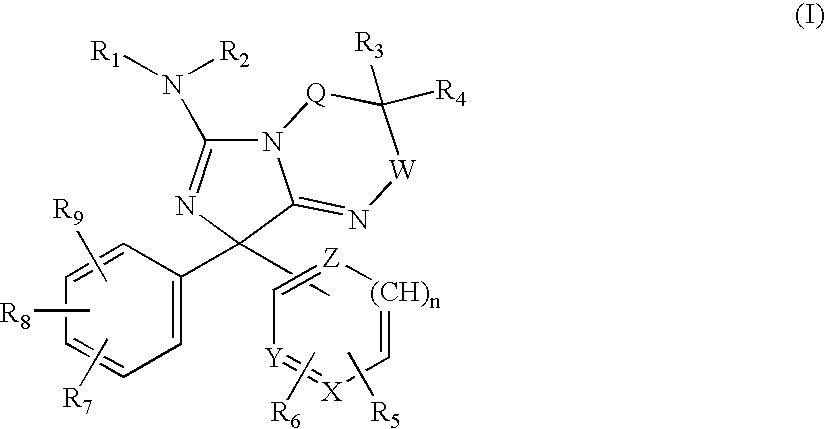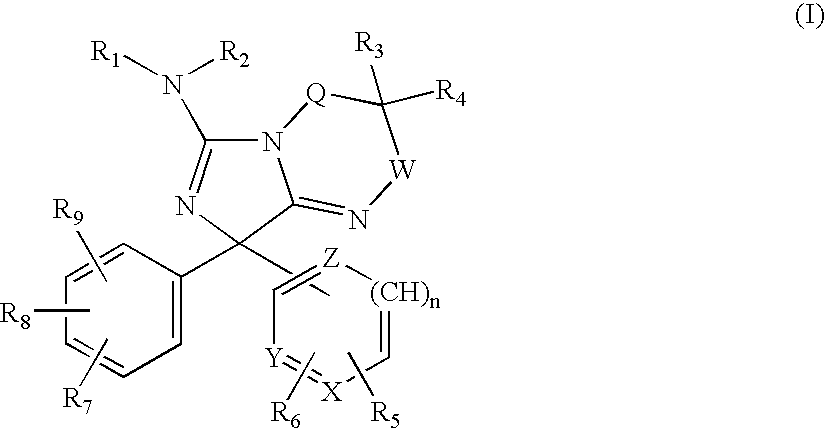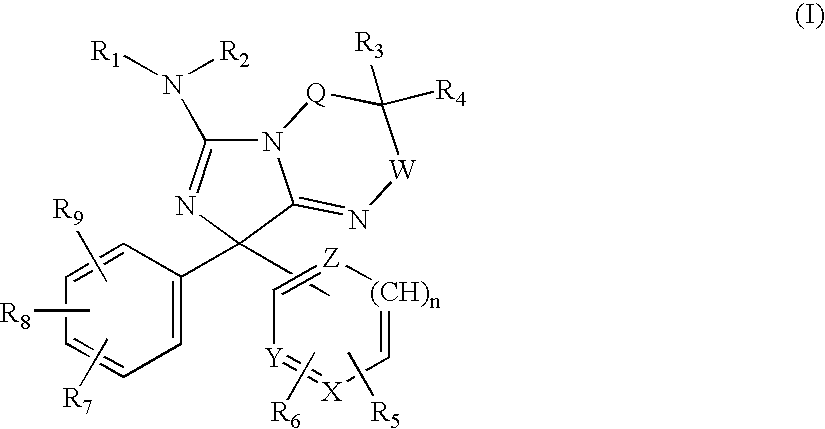Imidazole amines as inhibitors of beta-secretase
a technology of beta-secretase and imidazole amine, which is applied in the direction of biocide, organic chemistry, drug compositions, etc., can solve the problems of severe impairment, eventual death, and serious healthcare problems, and achieve the effects of improving -amyloid levels, preventing or reducing disease, and improving treatment, prevention or amelioration of diseas
- Summary
- Abstract
- Description
- Claims
- Application Information
AI Technical Summary
Benefits of technology
Problems solved by technology
Method used
Image
Examples
example 1
Preparation of 8-[3-(2-Fluoropyridin-3-yl)phenyl]-8-pyridin-4-yl-2,3,4,8-tetrahydroimidazo[1,5-a]pyrimidin-6-amine
[0086]
A) Preparation of Compound 1
[0087] A solution of tert-butyl lithium (30.0 mL of 1.7 M in pentane, 51.0 mmol) in diethyl ether, at −78° C., was treated dropwise with a solution of 4-bromopyridine (25.7 mmol) in diethyl ether, stirred at −78° C. for 40 min, allowed to warm to 0° C., treated sequentially with methanol and sodium borohydride (1.94 g, 51.0 mmol), stirred overnight at room temperature, diluted with saturated aqueous ammonium chloride and concentrated under reduced pressure to remove most of the methanol and diethyl ether. The resultant aqueous residue was extracted with methylene chloride. The extracts were combined, washed with brine, dried over sodium sulfate and concentrated in vacuo. Purification of this residue by flash chromatography (silica, methylene chloride to 95:5:0.25 methylene chloride / methanol / concentrated ammonium hydroxide) afforded com...
example 2
Preparation of 8-(2,6-Diethylpyridin-4-yl)-8-[3-(2-fluoropyridin-3-yl)phenyl]-2,3,4,8-tetrahydroimidazo[1,5-a]pyrimidin-6-amine
[0092]
[0093] Using essentially the same procedure described in Example 1 and employing 4-Bromo-2,6-diethylpyridine in Step A, the title product is obtained as a white solid, 0.095 g, mp 174-176° C.; 1H NMR (500 MHz, CDCl3) δ 8.16 (d, J=4.2 Hz, 1H), 8.04-7.98 (m, 1H), 7.54-7.37 (m, 5H), 7.13 (s, 2H), 3.70 (t, J=6.0 Hz, 2H), 3.50 (t, J=6.0 Hz, 2H), 2.75 (q, J=7.8 Hz, 4H), 1.87 (t, J=5.7 Hz, 2H), 1.23 (t, J=7.8 Hz, 6H); ESI MS m / z 443 [C26H27FN6+H]+
example 3
Preparation of 8-(1-Ethyl-1H-pyrazol-4-yl)-8-[3-(2-fluoropyridin-3-yl)phenyl]-2,3,4,8-tetrahydroimidazo[1,5-a]pyrimidin-6-amine
[0094]
A) Preparation of Compound 1
[0095] A mixture of t-butyl lithium (16.2 mL of a 1.7 M solution in pentane, 27.5 mmol) and diethyl ether was cooled to −78° C., treated dropwise over a 15 min. period with a solution of 4-bromo-1-ethylpyrazole (2.3 g, 13.1 mmol) in diethyl ether, stirred at −78° C. for 10 min, treated dropwise with a solution of 3-bromobenzonitrile (2.58 g, 14.1 mmol) in ether, stirred at −78° C. for 45 min and allowed to warm to room temperature for1 h. The reaction mixture was treated with anhydrous methanol, cooled to 0° C., treated with sodium borohydride (0.991 g, 26.2 mmol), warmed to room temperature, stirred for 1 h at to room temperature, cooled to 0° C. and quenched by the careful addition of saturated ammonium chloride until gas evolution had ceased and all precipitates had dissolved. The reaction mixture was diluted with meth...
PUM
| Property | Measurement | Unit |
|---|---|---|
| temperature | aaaaa | aaaaa |
| temperature | aaaaa | aaaaa |
| temperature | aaaaa | aaaaa |
Abstract
Description
Claims
Application Information
 Login to View More
Login to View More - R&D
- Intellectual Property
- Life Sciences
- Materials
- Tech Scout
- Unparalleled Data Quality
- Higher Quality Content
- 60% Fewer Hallucinations
Browse by: Latest US Patents, China's latest patents, Technical Efficacy Thesaurus, Application Domain, Technology Topic, Popular Technical Reports.
© 2025 PatSnap. All rights reserved.Legal|Privacy policy|Modern Slavery Act Transparency Statement|Sitemap|About US| Contact US: help@patsnap.com



